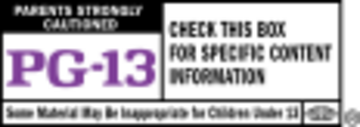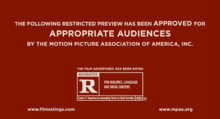Motion Picture Association film rating system facts for kids
The Motion Picture Association (MPA) has a film rating system used in the United States. This system helps families decide if a movie is right for certain age groups based on what's in it. The MPA, which used to be called the MPAA, is in charge of these ratings.
The MPA rating system is a choice, not a law. Movies don't have to get a rating, but most movie theaters won't show films that aren't rated or are rated NC-17. Other types of media, like TV shows, music, and video games, have their own rating systems from different groups.
This rating system started in November 1968. It helps parents choose movies that are suitable for their children. The ratings are managed by a special part of the MPA called the Classification & Ratings Administration (CARA).
Contents
Understanding Movie Ratings
The MPA uses different ratings to tell you about a film's content.
What Do MPA Film Ratings Mean?
Here are the main MPA film ratings and what they mean:
| Rating Symbol | What It Means |
|---|---|
|
|
|
|
|
|
|
|
|
|
|
|
|
|
|
Content Descriptors
Sometimes, a movie rating will come with a short description. These are called content descriptors. They explain why a movie got a certain rating. For example, a PG-13 movie might say "sequences of violence" or "some strong language." These descriptions help you understand what kind of content is in the film. G-rated movies don't have these descriptors because they are suitable for everyone.
Other Labels You Might See
- Not Rated (NR) or Unrated (UR): These labels mean the film was not submitted to the MPA for a rating. Sometimes, "Unrated" is used for longer versions of movies that were shown in theaters with a rating. These "Unrated" versions might have content that is different from the original and might not be suitable for kids.
- This Film Is Not Yet Rated: You might see this on movie trailers or commercials for films that haven't received their final rating yet.
Rules for Movie Promotions
The MPA also rates things that promote movies, like trailers, posters, and ads.
Movie Trailers
Rating cards appear at the beginning of movie trailers in the United States. They tell you if the trailer is suitable for all audiences or only for certain age groups.
- Green Band: If you see a green card at the start of a trailer, it means the trailer is approved for "appropriate audiences." This means the trailer follows the MPA's rules for advertising and is generally safe for everyone to watch. It won't have a lot of bad language or intense scenes.
- Yellow Band: A yellow card is used for trailers shown online. It means the trailer is approved "only for age-appropriate Internet users." These trailers might have content that's okay for older teens or adults, but not for younger kids. You usually see these for PG-13 movies or stronger.
- Red Band: A red card means the trailer is for "restricted" or "mature" audiences only. These trailers might have content that is not suitable for children, like scenes from R-rated or NC-17-rated movies. If you watch a red band trailer online, you might need to prove you are old enough by verifying your age.
Blue Feature Tags

The MPA also creates blue tags that you see after a movie in theaters or before a movie on home video (like DVDs or streaming). These tags show the movie's rating, any content descriptions, and the MPA logo.
See also
- List of highest-grossing R-rated films
- List of NC-17 rated films
- Common Sense Media
- Entertainment Software Rating Board
- TV Parental Guidelines














